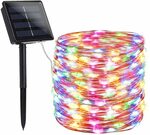A very decent price for a 200 LED 22m solar string lights (in comparison with Bunnings, etc).
Additional promotion: Buy 2, save 5%. Enter code YQDRZMC6 at checkout.
- LED color: Multicolor
- Solar Panel: 2V/300mA
- Battery type: Rechargeable 1200mAH NI-MH Battery
- Charging time: 6-8 hours
- Total length: 72ft (22m)
- Length from Solar panel to first LED: 6.5ft (2m)
- 8 different modes




 CamelCamelCamel
CamelCamelCamel

200 LEDs running off 1200mah wouldn't last very long